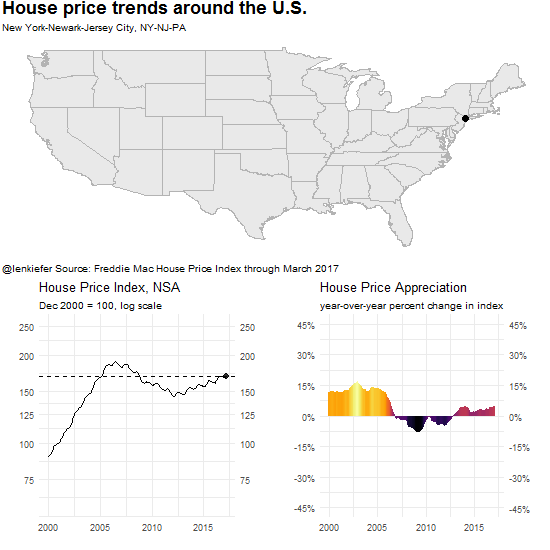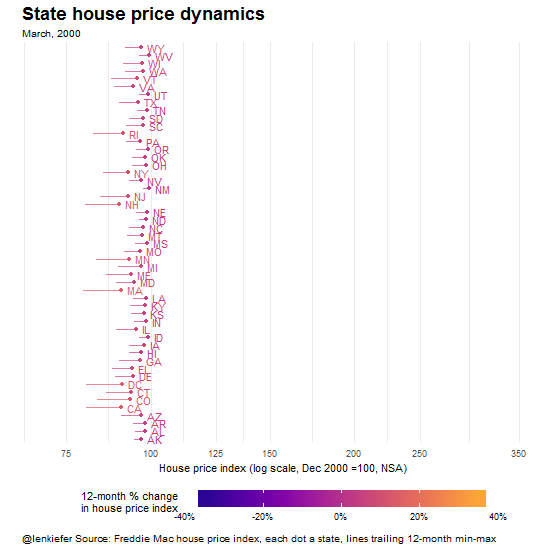I AM JUST GOING TO DROP OFF A COUPLE OF housing data animated gifs here. And add a little bit of code for data wrangling.
In earlier posts I described how to make these using R in greater detail. We’re going to be visualizing the Freddie Mac House Price Index.
Updated geo tour
We talked about how to build something like this in our Grand Tour of House Prices post

Dot chart
And for this one, you have to go way back to my Visual Meditation on House Prices Part 2. But I’ve updated the code for this below.

A little bit of data manipulation
Oh all right, I’ll post a little bit of code. Last month we talked about using readxl to wrangle some data in Excel spreadsheets.
Last year we saw how to manipulate data in Excel. Below, we’ll use readxl to get our data read for plotting.
You can download the Excel spreadsheet with state house price index values here. Note that this code is based on the release with data through March, 2017, future releases may shift the exact location of the cells. Using the range argument of readxl we can reach into the spreadsheet and get our data ready. Let’s try it:
library(zoo,quietly=T,warn.conflicts = F) # used for rolling window operations
library(readxl,quietly=T,warn.conflicts=F)
library(ggplot2,quietly=T,warn.conflicts=F)
library(tidyr,quietly=T,warn.conflicts=F)
library(dplyr,quietly=T,warn.conflicts=F)
library(lubridate,quietly=T,warn.conflicts=F)
library(data.table,quietly=T,warn.conflicts=F) # for the shift function
library(viridis,quietly=T,warn.conflicts=F) # for the colors
library(scales,quietly=T,warn.conflicts=F) # for labels
###############################################################################
#### Read in HPI data
###############################################################################
df<-read_excel("data/states.xls",
sheet = "State Indices", # name of sheet
range="B6:BB513" ) # range where data lives
###############################################################################
#### Set up dates from January 1975 to March 2017
###############################################################################
df$date<-seq.Date(as.Date("1975-01-01"),as.Date("2017-03-01"),by="1 month")
df.state<-df %>% gather(geo,hpi,-date) %>% mutate(type="state")Now that our data is loaded we can do some manipulations
###############################################################################
#### Transform data
#### Needs library zoo for the rolling window operations
###############################################################################
df.state<-
df.state %>% group_by(geo) %>%
mutate(hpa=hpi/shift(hpi,12)-1,
hpilag12=shift(hpi,12,fill=NA),
hpimax12=zoo::rollmax(hpi,13,align="right",fill=NA),
hpimin12=-zoo::rollmax(-hpi,13,align="right",fill=NA)) %>% ungroup()
# Get a list of dates
dlist<-unique(filter(df.state,year(date)>1999)$date)
###############################################################################
#### Plotting function
###############################################################################
myplot1 <- function (i) {
g<-
ggplot(data=filter(df.state,date==dlist[i] &
!(geo %in%
c("United States not seasonally adjusted",
"United States seasonally adjusted" ))),
aes(x=hpi, y=geo, label=paste(" ",geo,""),
color=hpa,hjust=ifelse(hpa>0,0,1)))+
geom_text() +
geom_point()+
scale_x_log10(limits=c(70,352), breaks=c(75,100,125,150,200,250,350))+
geom_segment(aes(xend=hpimin12,x=hpimax12,y=geo,yend=geo),alpha=0.7)+
theme_minimal() +
theme(legend.position="bottom",
axis.text.y=element_blank(),
legend.key.width=unit(4,"line"),
panel.grid.major.y=element_blank(),
plot.caption=element_text(hjust=0),
plot.title=element_text(face="bold",size=18))+
scale_color_viridis(end=0.85,option="C",limits=c(-.4,.4),
name="12-month % change \nin house price index \n",
label=percent)+
labs(y="", x="House price index (log scale, Dec 2000 =100, NSA)",
title="State house price dynamics",
subtitle=as.character(dlist[i],format="%B, %Y"),
caption="@lenkiefer Source: Freddie Mac house price index, each dot a state, lines trailing 12-month min-max")
return(g)
}
N<-length(dlist) #get number of observations in filtered data
myplot1(N)
Add animation
With our function, we can easily add some animation and create gif.
oopt = ani.options(interval = 0.15)
saveGIF({for (i in seq(3,N,1)) {
g<-myplot1(i)
print(g)
print(paste(i,"out of",N))
ani.pause()}
for (i in 1:5)
{print(g)
print(i)}
},movie.name="geo tween 05 02 2017 dotrace.gif",ani.width = 550, ani.height = 550)